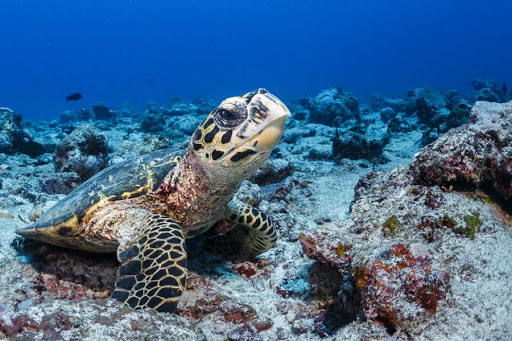The Saudi Arabian Special Forces for Environmental Security have made several arrests for disturbing Turtle nests in the Umluj Governate of the Tabuk Region, on the northern part of the country's Red Sea coast, after video clips of men 'abusing' Turtles appeared on social media. The islands of the Umlaj area are considered to be an internationally important breeding area for several species of Turtle, and the 'possession, disturbance, mutilation, destruction, selling, transference, molestation and harassment of marine turtles, nests or eggs' is prohibited under Saudi law.
The approximate location of the Umluj Governate. Google Maps.
Four species of Turtle are known to nest in the 102 islands of the Umluj Governate, the Green Turtle, Chelonia mydas, the Hawksbill Turtle, Eretmochelys imbricata, the Loggerhead Turtle, Caretta caretta, and the Olive Ridley Turtle, Lepidochelys olivacea.
The Green Turtle, Chelonia mydas, is found throughout the tropics, but are considered to be Endangered under the terms of the International Union for the Conservation of Nature's Red List of Threatened Species, due both to loss of breeding grounds and vulnerability to a wide range of fishing techniques. The species favours flat, sandy beaches on warm coasts as a nesting site, which is also the environment favoured by the tourist industry for new developments, creating a direct conflict between the industry and efforts to conserve the species, making nesting sites in areas without extensive tourist developments particularly vulnerable. These Turtles are also highly vulnerable to the fishing industry, easily becoming entangled in nets, where they typically drown rapidly, as well as often taking bait on long lines, which also typically leads to rapid drowning.
The Hawksbill Turtle, Eretmochelys imbricata, is considered to be Critically Endangered under the terms of the International Union for the Conservation of Nature's Red List of Threatened Species. This species is found throughout tropical, subtropical and warm temperate seas, and like the Green Turtle is vulnerable to the loss of breeding grounds and entrapment by fishing gear. This species is also more prone to deliberate hunting, for meat and its shells, which are used to make a range of decorative items, than Green Turtles (though that species is not immune from either problem). Importantly, the Hawksbill Turtle has a much slower reproduction cycle than the Green Turtle, with individuals typically not reproducing until they are in their thirties, which makes them far more vulnerable to Human pressures, as individuals must survive for longer before breeding. There are thought to be only about 8000 female Hawksbill Turtles of breeding age surviving globally.
A Hawksbill Turtle, Eretmochelys imbricata, in the Maldives. Olive Ridley Project.
The Loggerhead Turtle, Caretta caretta, are considered to be Vulnerable under the terms of the International Union for the Conservation of Nature's Red List of Threatened Species, as they are at risk from the same pressures as other Turtles, and have suffered some population declines, but are not immediately at risk. This is largely due to their more rapid breeding cycle, with females able to produce 3-6 clutches of eggs per year. There are currently 36 000-67 000 breeding female Loggerhead Turtles at 135 known breeding sites globally.
The Olive Ridley Turtle, Lepidochelys olivacea, are again considered to be Vulnerable under the terms of the International Union for the Conservation of Nature's Red List of Threatened Species. They are found throughout the tropics, and are vulnerable to the same pressures as other Turtles, but while they are known to have suffered population declines, are still present in very large numbers in some areas, with up to half a million Olive Ridley Turtles breeding on the coast of the Indian state of Odisha alone each year. This is again due to a high reproductive rate, with females laying clutches containing an average of 105 eggs, around 50% of which can reach breeding age, less than a decade later.
See also..
Follow
Sciency Thoughts on Facebook.











